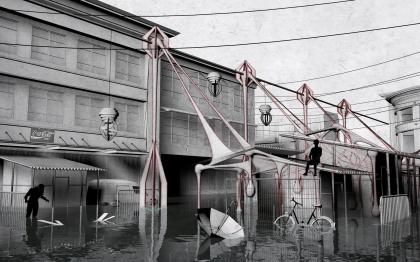Hi Nanette and Ricardo, I’m very sorry for the late upload. The text below explains the drawing I’ve been working on. I am also working on a section of the most recent iteration of the gate, which will hopefully clarify the narrative in this drawing.
Most of my site in Phnom Penh doesn’t officially exist. The slum dwellings are like ghosts, unmapped and unrecognised. In the midst of a real estate boom and grey property laws, families are continuously evicted and relocated. It is a non place. How can one inhabit nowhere?
Using the typological precedent of the ‘City Gate’ (originally a cardinal device), the community can exist in two parallel worlds. The existing site, with informal housing built against larger structures, and the impermanent site, ruined skeletons of the houses that once were. This ruined infrastructure is shown in the drawing below. Devices harvest the materials from the ruins to use in building the ‘City Gate’ in an annual ritual. In this way, the homes that are lost are remembered every year at the end of the flooding monsoon season, and the skeleton that remains can be re-appropriated.
The gate is the origin of an infrastructure that immortalises ghost dwellings, and the ruins that are constructed follow specific paths, orientated around the lives of a fleeting community. The paths that they follow could not be directed any other way, because it has been informed by the site’s fragmented history.
1 Comment so far
Leave a comment

Hi Jocelyn,
It is great to see how the image help you mature the design. It has a certain scenario tone to it (flood elements) that could be further explored on the design aspect. Rather than just thinking about the mechanisms of ‘how’ it would be good to see a follow up image of the gate in different stages of its ‘carcass to flesh’ type of process. The material and formal qualities of the gate mass is something that can be significant and exciting to develop.
In a separate note the participative aspect of people and the structure can and should be more elaborated. People may get together on the image in a less strict system organization base but it may open some doors for you to think how that interaction could occur later (where drawings could the pick it where the image left).
Carry on! It is very important that you develop those aspects before the school returns to avoid catching up rather than enjoying the final sprint.
Comment by tutor April 18, 2014 @ 12:23 pm